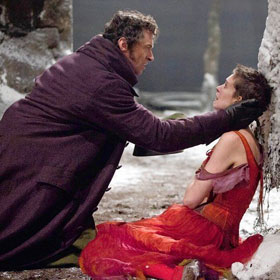'Les Miserables' Movie Review: Hugh Jackman Shines

3.5/5
Victor Hugo's voluminous piece of literature has seen itself time and again brought to life – be it by stage or by screen. Each adaptation of Les Miserables carries with it the characters and their miseries. Tom Hooper, in his adaptation, unlike all film directors who’ve tried their hand at a movie musical before him, dared to have the actors sing live. It was new, it was risky, it was interesting, but was it worth it?
The film opens with Hugh Jackman as Jean Valjean laboring on a chain gang singing "Look Down" (the only prerecorded number in the movie) as Javert, played by Russell Crowe, imperiously looks down upon the prisoners. Jackman is as believably haggard and downtrodden as Crowe is domineering. "Retrieve the flag," he orders Jean Valjean in one of the only bits of unsung dialogue throughout the film – and the last time Crowe embodies his character.
Crowe is the least successful actor singing live on camera. The estimable actor struggled with the multi-tasking of playing his part and delivering in the vocal department. Crowe's face strained with his efforts to belt out the lyrics, rather than with the deliberation of his character Javert. Helena Bonham Carter and Sacha Baron Cohen, as the Thenardiers, have equally unreliable voices, yet their joint comedic acting manages to transcend their less than impressive pipes, making "Master of the House" a nice respite from the melancholy throughout the rest of the story.
As Fantine, Anne Hathaway's "I Dreamed A Dream" is probably the best usage of Hooper's directorial methods. She's able to act through the song; making every line drip with emotion and sacrificing pretty singing for the rawness and depth of Fantine's woe. Jackman seemed to revel in putting his theatre chops on display, and would have stood out had their not been so many other talents on display. Despite early criticism of Eddie Redmayne’s musical efforts as Marius, Fantine’s daughter Cosette's (Amanda Seyfried) love interest, his sincere performance was one of the most moving. Aaron Tveit, a broadway veteran, took a powerful turn as Enjolras, giving meat to the songs sung with Redmayne’s Marius, and enlivening the movie's audience as he belts "Red and Black."
While the movie makes the song the center, it also provides for some visually stunning moments. In one, after Valjean is caught with silver belonging to the Monseigneur, who had taken him in the night before, he is pardoned by him. The Monsigneur claims to have given away all of these possessions to this wayward criminal, thereby absolving Valjean and freeing him to make a new name for himself. Tearing up his papers in the hilltop church cemetery before a picturesque sky, Valjean becomes Monsier Madeleine. In another scene, Javert toes the bridge railing over the river Seine and eventually allows himself to fall into the treacherous waters. While an incredible scene visually, those less familiar with Les Miserables may not have seen the progression within Crowe or the story that would have led to such a demise.
While the first half of the film follows Valjean from prisoner, to successful foreman, to a man on the run with a young child in his care, the second half of the film plays out the love triangle between Marius, Cosette, and the Thenardier's daughter Eponine – played wonderfully by stage actress Samantha Barks. It's Eponine's unrequited and unrecognized love for Marius that leads to Banks's touching performance of "On My Own" walking through the rain slicked streets.
As Les Miserables comes to a close, Jean Valjean confides in Marius about his past and pleads with him to understand why he must leave and also why Cosette may never know the truth about him. Yet, at Marius and Cosette's wedding, the Thenardier's incidentally reveals to Marius that Valjean was the one who saved his life as his barricade fell against the French army. And later, they divulge Valjean’s supposed hiding place. The newly married couple find a much aged Valjean sitting weakly in a chair at a nunnery. As all the truths are revealed, Valjean is called to death by an angelic vision of Fantine and the Monsigneur who saved his life. The final scenes see all of the fallen men and women of misery in France’s capital singing about the coming of tomorrow.
Hooper’s Les Miserables is rife with memorable performances – a gaunt Hathaway with her hair spiky and strewn crying through “I Dreamed a Dream” taking up a third of the screen while the rest is cloaked in blackness, the anarchist rebels waving flags for freedom as they overwhelm a government parade on the streets of Paris, Cosette being held by Marius as her father is stolen from her by death just moments after knowing him for the first time. But, the movie taken as a whole fell short of deserving the unbridled praise it was seeking. It lacked the thread to bring all of the better performances together, asked certain actors to do more than they were able, and most likely suffered from the Oscar-hungry overexposure that eager films sometimes do.
For more like this 'Les Miserables' movie review, check out Uinterview's movie review section here.
RELATED ARTICLES
Get the most-revealing celebrity conversations with the uInterview podcast!



 by
by 



Leave a comment